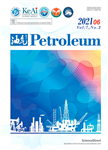Cross-flow analysis of injection wells in a multilayered reservoir
作者机构:Geological InstituteETH ZurichZurichSwitzerland Baker HughesAberdeenUnited Kingdom Geomec Environmental Management ASStavangerNorway Earth&Environmental Sciences DepartmentUniversity of WaterlooWaterlooONCanada
出 版 物:《Petroleum》 (油气(英文))
年 卷 期:2016年第2卷第3期
页 面:273-281页
学科分类:080704[工学-流体机械及工程] 080103[工学-流体力学] 08[工学] 0807[工学-动力工程及工程热物理] 0801[工学-力学(可授工学、理学学位)]
主 题:Cross-flow Multilayered Sandstone reservoir Sand production Skin factor
摘 要:During fluid injection into a multilayered reservoir,a different pressure gradient is generated across the face of each permeable *** pressure gradient generates driving forces in the wellbore during well shut-in that causes the injected fluid moves from higher pressure layers to lower pressure layers,a phenomenon known as interwell ***-flow behavior depends on the initial pressure in the permeable layers and may be referred to as natural cross-flow(identical or natural initial pressures)and forced cross-flow(different initial pressures because of exploitation).Cross-flow may induce sand production and liquefaction in the higher pressure layers as well as formation damage,filter cake build-up and permeability reduction in the lower pressure ***,understanding cross-flow during well shut-in is important from a production and reservoir engineering perspective,particularly in unconsolidated or poorly consolidated sandstone *** and forced cross-flow is modeled for some injection wells in an oil reservoir located at North *** solution uses a transient implicit finite difference approach for multiple sand layers with different permeabilities separated by impermeable shale *** and forced cross-flow rates for each reservoir layer during shut-in are calculated and compared with different production logging tool(PLT)*** appears that forced cross-flow is usually more prolonged and subject to a higher flow rate when compared with natural cross-flow,and is thus worthy of more detailed analysis.



